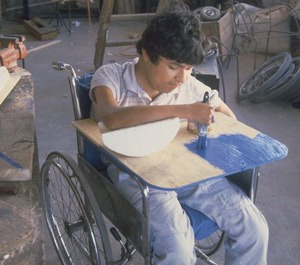Hesperian Health Guides
Questions About Muscular Dystrophy
HealthWiki > Disabled Village Children > Chapter 10: Muscular Dystrophy: Gradual, Progressive Muscle Loss > Questions About Muscular Dystrophy
What causes it? A genetic change, which can be inherited, that affects the genes that make muscle proteins. But in 2 out of 3 families with muscular dystrophy, there is a history of it among male relatives of the mother. Though the parents are usually unaffected, the mother carries the gene that produces dystrophy in her sons. Her daughters will not be affected, but they may have sons with muscular dystrophy.
What treatment is there? There is no cure. But medicines, such as cortico-steroids or ACE inhibitors if the heart is affected, along with therapy or exercises may slow the increasing weakness. Surgery to release tiptoe contractures is at best of temporary benefit.
The family can, however, do much to help the child make the best of his life and adapt to his limitations as they progress.

Also, activities, exercises and braces to prevent contractures may help the child to keep walking longer. If the child sits in a bad position, pillows or supports to help him sit straighter can help prevent deformities.
Is the child’s mind affected? About half of these children have cognitive delay.
 |
| A boy with muscular dystrophy paints the top of his wheelchair table. Although he cannot lift his arm without help, a simple ‘arm rocker’ made of foam plastic lets him move it in all directions. It also allows him to feed himself. |
What can be done? The family can do many things to help the child live more fully and happily. The child should remain active and continue normal activities for as long as possible. Play with other children is important. So are learning and exploring. The child should go to school. Encourage other children to help him with learning and play. The teacher should realize that some—but not all—children with dystrophy take a little more time to learn than other children. Try to include the child in as many family and community activities as possible.
The steadily increasing weakness and the lack of effective treatment will be hard for both the family and child to accept. Friendly assistance, advice, and encouragement from health workers and friends can be a big help. Help the family to look at the situation honestly, and to do their best.
The goal of the family is to help the child be as active and happy as possible, and to adjust to his increasing limitations.


